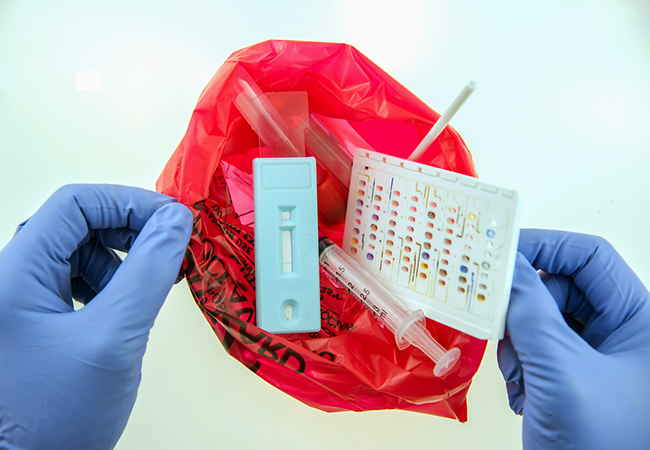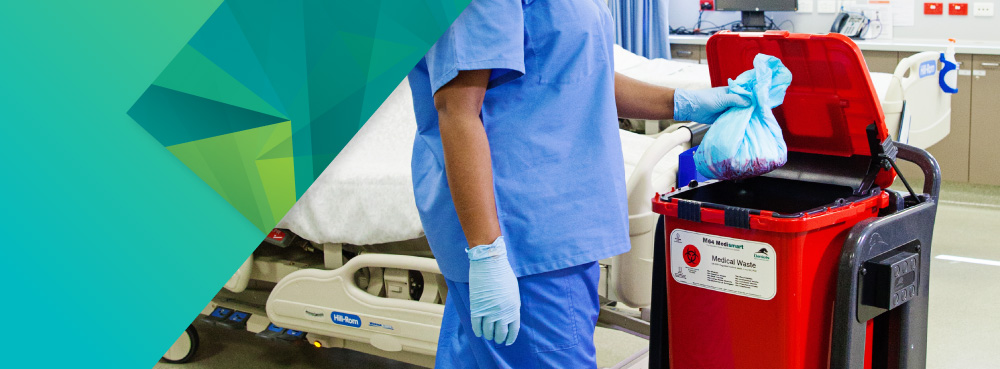Medical Waste Removal Quality: Elevating Safety Specifications in Your Facility
Medical Waste Removal Quality: Elevating Safety Specifications in Your Facility
Blog Article
Minimize Expenses and Optimize Safety: Effective Medical Waste Disposal Methods
Reliable clinical waste disposal approaches are vital for health care facilities to optimize and decrease expenses safety. With the expanding issue for ecological sustainability and the enhancing number of policies bordering waste monitoring, it is crucial for health care companies to take on efficient and compliant methods. By carrying out correct segregation and categorization, effective product packaging and labeling, risk-free transportation and handling, effective therapy and disposal techniques, and conformity with regulatory guidelines, healthcare facilities can make sure the risk-free and liable administration of clinical waste. In this discussion, we will certainly discover each of these methods carefully, offering insights and sensible tips for healthcare professionals to optimize their waste disposal procedures.

Appropriate Segregation and Classification
Appropriate partition and classification are essential elements of effective medical waste disposal techniques, guaranteeing the security of medical care workers, the public, and the setting - medical waste removal service. medical waste disposal services with WasteX. By dividing different kinds of clinical waste at the factor of generation, medical care facilities can minimize the threat of cross-contamination and prospective injury to individuals and environments
Among the vital consider correct segregation is the identification and category of clinical waste. This includes categorizing waste into different groups, such as contagious, dangerous, radioactive, or pharmaceutical waste. Each category needs certain handling, storage, and disposal techniques to stop any kind of unfavorable impacts on human health and the atmosphere.
Moreover, proper partition likewise includes using color-coded labels and containers to clearly identify and separate the different types of clinical waste. This aids health care workers and waste administration employees to conveniently recognize and manage the waste appropriately. Red containers may be used for infectious waste, while yellow containers may be marked for harmful waste.
In enhancement to partition, appropriate categorization likewise involves the appropriate packaging and containment of clinical waste. This makes certain that waste is firmly kept and delivered without presenting any dangers to individuals or the setting. Making use of leak-proof and puncture-resistant containers, as well as appropriately securing and identifying them, aids to stop any unexpected exposure or release of hazardous substances.
Effective Product Packaging and Labeling
Reliable product packaging and labeling play a crucial duty in ensuring the efficient and safe disposal of clinical waste. Appropriate product packaging is vital to stop leak, damage, or splilling during transportation and handling. It aids to decrease the threat of contamination and shields healthcare workers, waste monitoring workers, and the environment from potential threats.
Clinical waste must be packaged in durable and watertight containers that are resistant to penetrate and damage. These containers ought to be properly sealed to avoid any kind of leakage. Furthermore, the packaging needs to be able to withstand the conditions of transport, consisting of temperature variants and harsh handling.
Identifying is just as crucial as it supplies critical details about the materials of the waste and any kind of possible risks connected with it. The tags should include the name of the health care facility, the kind of waste, and any special delivery guidelines. Standard and clear labeling guarantees that waste monitoring personnel can easily identify and take care of the waste properly.
Effective product packaging and labeling additionally aid in the correct segregation and classification of medical waste. Clear labeling enables very easy recognition of various waste streams, such as contagious waste, sharps, or pharmaceutical waste. This assists in improving the disposal process and making sure that the waste is dealt with or thrown away in accordance with regulative standards.
Safe Transportation and Handling
Ensuring the safe transportation and handling of medical waste is of utmost importance in order to prevent any kind of potential health and environmental visit this web-site threats. Medical waste, such as sharps, polluted products, and pharmaceutical waste, should be appropriately packaged and dealt with to lessen the risk of exposure to unsafe materials and pathogens.
Delivering clinical waste calls for compliance with rigorous regulations and guidelines established by ecological companies and neighborhood authorities. These laws intend to safeguard the health and wellness of workers associated with waste monitoring and prevent the launch of harmful products into the atmosphere.
To make certain risk-free transport, clinical waste ought to be positioned in watertight and puncture-resistant containers that are correctly sealed and labeled. These containers should be protected in a manner that protects against spills or damage throughout transportation (medical waste removal service). In addition, it is vital to use specific vehicles outfitted with suitable safety and security functions to move clinical waste. These cars should have sufficient ventilation and be developed to avoid leakage or contamination.
Dealing with medical waste likewise requires correct training and adherence to safety protocols. Employees involved in the handling of clinical waste need to use appropriate individual protective equipment (PPE) such as gloves, dress, and masks to decrease the risk of direct exposure. They need to likewise comply with stringent hygiene techniques to stop the spread of infections and make certain the risk-free disposal of waste.
Reliable Treatment and Disposal Techniques
Carrying out proper therapy and disposal techniques is critical in handling medical waste successfully and decreasing possible health and environmental threats. Clinical waste, that includes sharps, infectious materials, chemicals, and drugs, can present significant risks otherwise managed and thrown away appropriately. There are a number of therapy and disposal techniques offered that follow governing guidelines and advertise risk-free methods.
One usual approach is incineration, which involves burning the waste at high temperature levels. Incineration is reliable in ruining pathogens and decreasing the quantity of waste, but it can release dangerous toxins right into the air otherwise effectively managed. As a result, it is essential to use contemporary burners equipped with discharge control innovations.
One more technique is autoclaving, which uses vapor and pressure to decontaminate the waste. Autoclaving is reliable in eliminating microorganisms and minimizing the quantity of waste, but it calls for cautious surveillance and upkeep to make sure appropriate performance. The disinfected waste can then be securely disposed of in a landfill.
Chemical treatment is one more alternative, which includes utilizing anti-bacterials or various other chemicals to reduce the effects of pathogens. This method is commonly made use of for liquid waste, such as laboratory specimens. It is crucial to utilize suitable chemicals and comply with proper treatments to make certain reliable treatment and prevent ecological contamination.

Conformity With Regulatory Guidelines
Abiding by regulatory guidelines is important in guaranteeing correct compliance with medical waste disposal techniques. These guidelines are put in area to shield public wellness, avoid ecological contamination, and preserve work environment security. Conformity with regulatory standards is important for healthcare centers, as non-compliance can result in penalties, fines, and reputational damage.
Regulative standards lay out the correct handling, storage, transportation, and disposal of medical medical waste disposal services with WasteX waste. They provide certain medical waste disposal services with WasteX instructions on product packaging needs, labeling, and record-keeping. These guidelines likewise attend to the partition of various waste streams, such as sharps, infectious waste, and pharmaceutical waste. Healthcare facilities must make certain that their waste monitoring practices straighten with these standards to lessen the danger of exposure to unsafe materials and avoid the spread of infections.
To maintain compliance, healthcare facilities must establish detailed waste monitoring programs that consist of personnel training, normal audits, and continuous monitoring. It is necessary to maintain up-to-date with any type of updates or modifications to regulatory standards, as techniques may progress over time. By staying educated and applying correct methods, healthcare centers can reduce the capacity for governing offenses and safeguard the health and wellness of their team, patients, and the bordering neighborhood.
Final Thought
In verdict, carrying out reliable clinical garbage disposal techniques is critical for making best use of and lessening expenses safety. Appropriate partition and categorization, efficient product packaging and labeling, safe transport and handling, and efficient treatment and disposal methods are essential actions to make sure compliance with regulative guidelines. medical waste removal services. By sticking to these methods, medical care centers can protect the atmosphere and public health while also reducing financial worries associated with clinical waste management
By executing correct segregation and classification, efficient product packaging and labeling, risk-free transportation and handling, efficient treatment and disposal methods, and compliance with regulative standards, healthcare facilities can guarantee the accountable and secure monitoring of medical waste. Red containers may be utilized for transmittable waste, while yellow containers might be marked for hazardous waste.
Standard and clear labeling guarantees that waste management workers can easily recognize and deal with the waste properly. (medical waste disposal services with WasteX)
Clear labeling allows for easy recognition of different waste streams, such as infectious waste, sharps, or pharmaceutical waste. These guidelines additionally attend to the partition of different waste streams, such as sharps, infectious waste, and pharmaceutical waste.
Report this page